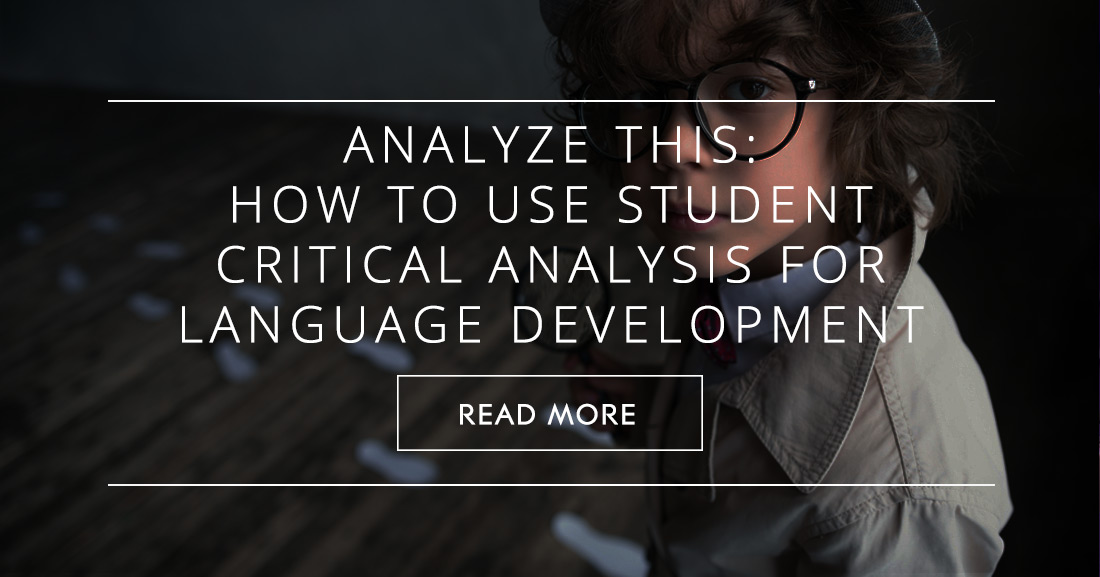8 Simple Steps to the Best Lesson You’ll Teach All Year


Remember the rules of grammar. Understand what a certain tense means. Apply that knowledge by using that tense to express your experiences or hopes. That’s the gist of teaching English as a second language. Get your students to recognize and remember the language you teach. Understand it, for what good is language if you don’t have any comprehension. And apply those skills to their own lives and attempts to communicate. The thing is, all of those skills are what some might call lower level thinking. They are the basics for how the mind works. It’s our challenge as teachers, even as language teachers, to get our students to use higher level thinking skills - to create, evaluate, and analyze. It may take a little effort on your part and your students’, but higher level thinking has long term benefits you can’t ignore. Here’s one way to make it work.
Critical analysis also called critical thinking means different things to different people. In general, though, it means observing a situation and making some kind of value judgement. When we encourage critical analysis among our students, we ask them to look at a situation, examine the facts, decide what is good and bad about that situation, and take action based on that thought process. This is a great activity for English language learners particularly if you can get them thinking in English throughout the process. Of course you can’t control that, but you can encourage it, and you should.
You can encourage analysis among your ESL students in lots of ways. One of the best I have found is through the process of doing a research report. Research reports are particularly valuable for students who will be attending higher education in English. Throughout my years of teaching ESL, I’d say that was about seventy to eighty percent of my students. Research reports challenge students to think critically, read and research, write about the information they have found, and talk about it when you tack on a presentation of their results, which I usually do. Most often I let my students choose the subject they will research since it tends to increase their engagement throughout the process, and walking ESL students through a research project can be a very long process. If you want to give your students more direction as to the topic of their research, that works, too.
After deciding on the topic for research, one of the first steps in writing a research report is determining what information you need. Students have to think about what they already know, decide where they are lacking in knowledge, and plan a strategy for finding that information. Sound familiar? It should because it’s almost exactly the process of critical analysis. Observe, make a judgement, and act on that decision. To help students determine what information they will need to complete their research report, ask them the following questions.
Follow up the activity by brainstorming with your class a comprehensive list of where they can find the information they need. Then set your students free to do some research.
The next place where critical analysis comes into play is when assessing the information students find. What constitutes a good resource? Before you ask students this question, discuss the difference between fact and opinion and interpretation. Also discuss the difference between correlation and causation. You might want to check out Spurious Correlations for some interesting examples to show your students during this discussion.
For your next class, have students bring in several varied sources they have found during their research. You can encourage them to include such items as comics, pictures, articles, books, etc.
Then have your students analyze the information they have collected. Ask them to observe their materials and decide if each one presents facts, opinions, or interpretations. After deciding the function of each source, students can then decide which materials are good and which not as good for their research.
You might take the analysis of resources a step further and create class rubric for deciding which sources are good for research. During the research process, ask student to find three websites that discuss the topic they are researching and bring in the information they find there. Two of these websites they should consider good resources and the third should be something they think misrepresents the topic.
In groups of around four, have students discuss what criteria they used to determine if a website was a good resource or a bad one. Ask students to make list. Then come back together as a class to discuss the criteria together. As a class, formulate a rubric to determine the validity of a website and encourage students use that rubric in subsequent research.
Once students have completed their research, they should begin writing the report. As they write, encourage students to express their own opinions. But ask them to support those opinions with facts, statistics, quotes from reliable sources, and other information that meets the criteria of the rubric you created as a class. Again they will be doing critical analysis as they determine what information best supports their ideas.
But I hope that by looking at pieces of the process you see how encouraging students to think analytically will help them deepen and develop their use of the English language. It’s easy to get caught up in the basics of thinking, and there’s nothing wrong with that. We just have to get beyond that at times to think in more complex ways if we are to give our students the best education possible.